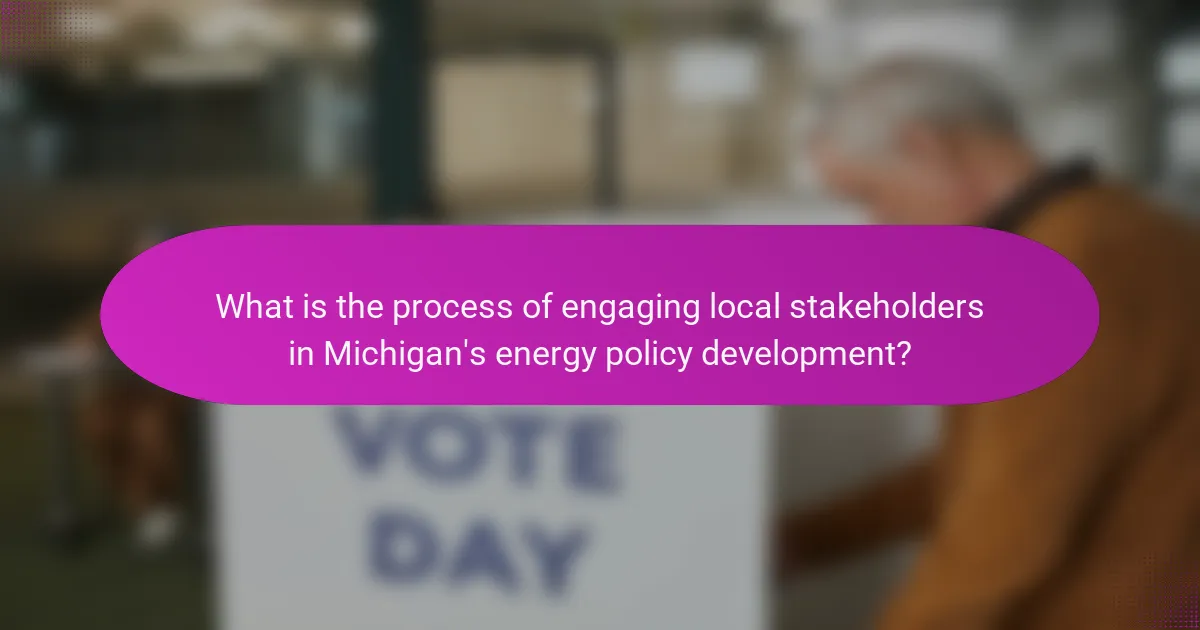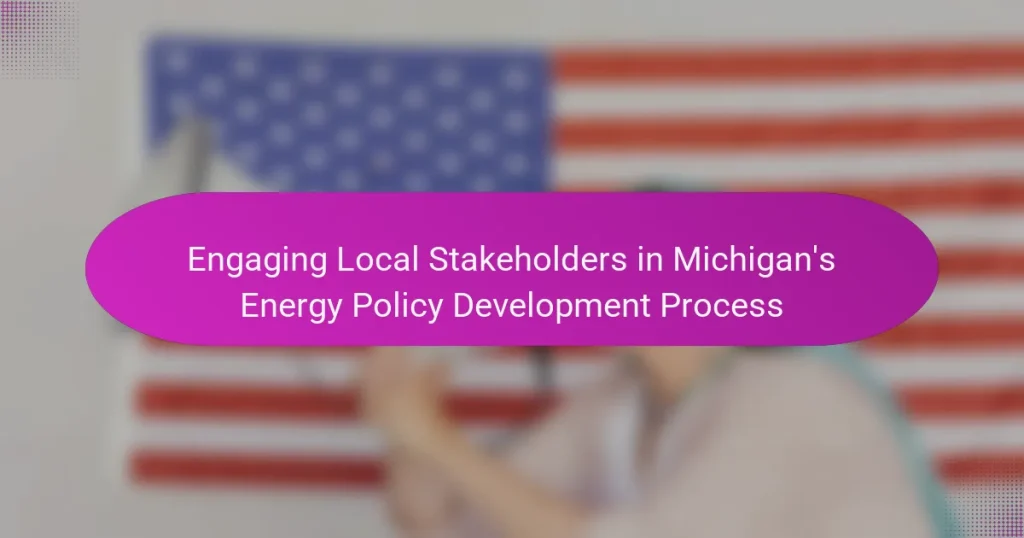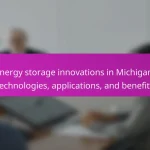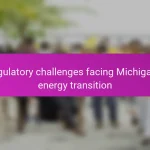
What is the process of engaging local stakeholders in Michigan’s energy policy development?
The process of engaging local stakeholders in Michigan’s energy policy development involves several key steps. First, state agencies identify relevant stakeholders, including local governments, community organizations, and residents. Next, they conduct outreach to inform stakeholders about ongoing energy initiatives and policy proposals. This outreach often includes public meetings, workshops, and surveys to gather feedback. Stakeholders are encouraged to participate in discussions to express their concerns and preferences. Additionally, agencies may establish advisory committees to ensure ongoing stakeholder involvement. Feedback collected is analyzed and integrated into policy recommendations. This collaborative approach aims to create energy policies that reflect local needs and priorities.
Why is stakeholder engagement important in energy policy development?
Stakeholder engagement is crucial in energy policy development because it fosters collaboration and inclusivity. Engaging stakeholders ensures that diverse perspectives are considered in decision-making. This approach leads to policies that are more effective and widely accepted. Research indicates that inclusive processes result in better implementation outcomes. For instance, the National Renewable Energy Laboratory found that stakeholder involvement can enhance trust and transparency in energy initiatives. Moreover, effective engagement can identify potential challenges early, allowing for proactive solutions. Overall, stakeholder engagement strengthens the legitimacy and sustainability of energy policies.
What roles do local stakeholders play in shaping energy policy?
Local stakeholders play critical roles in shaping energy policy by providing input, expertise, and community perspectives. They include residents, businesses, local governments, and non-profit organizations. These stakeholders contribute valuable insights based on local needs and conditions. They can influence policy through public comments, participation in advisory committees, and advocacy efforts. Their engagement ensures that energy policies reflect community priorities and sustainability goals. For example, local governments often advocate for renewable energy initiatives that align with their climate action plans. Research shows that stakeholder involvement leads to more effective and accepted energy policies. This is evident in Michigan’s energy policy development, where local input has shaped initiatives to enhance energy efficiency and renewable energy use.
How does stakeholder engagement impact policy outcomes?
Stakeholder engagement significantly influences policy outcomes by fostering collaboration and ensuring diverse perspectives are considered. Engaged stakeholders provide valuable insights that enhance the relevance and effectiveness of policies. Research shows that policies developed with stakeholder input are more likely to be accepted and implemented successfully. For instance, a study by the National Academy of Sciences found that stakeholder involvement can lead to more informed decision-making and improved public trust in policy processes. Additionally, policies shaped through engagement often address community needs more effectively, resulting in better long-term outcomes.
Who are the key local stakeholders in Michigan’s energy landscape?
Key local stakeholders in Michigan’s energy landscape include utility companies, state agencies, and local government entities. Major utility companies like DTE Energy and Consumers Energy play significant roles in energy generation and distribution. State agencies such as the Michigan Public Service Commission oversee regulatory frameworks. Local governments engage in energy planning and policy implementation. Non-profit organizations advocate for sustainable energy practices. Community groups also contribute to discussions on energy equity and access. These stakeholders collaborate to shape Michigan’s energy policies and initiatives.
What types of organizations are considered local stakeholders?
Local stakeholders include community organizations, non-profits, local governments, and businesses. These entities play a significant role in local decision-making processes. Community organizations often represent the interests of residents. Non-profits may focus on specific issues such as environmental protection or social justice. Local governments are responsible for implementing policies that affect the community. Businesses contribute to the local economy and can influence policy through advocacy. Together, these organizations help shape the energy policy development process in Michigan. Their involvement ensures that diverse perspectives are considered in decision-making.
How do demographic factors influence stakeholder involvement?
Demographic factors significantly influence stakeholder involvement by shaping interests, perspectives, and engagement levels. For instance, age can affect priorities; younger stakeholders may prioritize sustainability while older ones focus on economic stability. Geographic location also plays a role; urban stakeholders may have different concerns than rural ones. Education level influences understanding of energy policies, impacting participation rates. Additionally, cultural background can shape values and priorities in energy development. Research indicates that diverse stakeholder representation leads to more comprehensive policy outcomes. Studies show that inclusive engagement strategies improve stakeholder satisfaction and policy acceptance.
What challenges exist in engaging local stakeholders in the energy policy process?
Engaging local stakeholders in the energy policy process faces several challenges. One major challenge is the lack of awareness among stakeholders about the energy policy issues. Many local stakeholders may not understand the complexities of energy policies. This can lead to limited participation in discussions and decision-making processes. Additionally, there is often a disconnect between policymakers and local communities. This gap can result in policies that do not reflect the needs or concerns of the local population. Another challenge is the diversity of stakeholder interests. Different groups may have conflicting priorities, making consensus difficult. Furthermore, limited resources can hinder stakeholder engagement efforts. Communities may lack the funding or support needed to participate effectively. Lastly, time constraints can also pose challenges. Stakeholders often have other commitments that limit their availability for engagement activities.
What barriers do stakeholders face when participating in policy discussions?
Stakeholders face several barriers when participating in policy discussions. Limited access to information can hinder their engagement. Many stakeholders lack awareness of the policy issues at hand. This lack of knowledge can result in reduced participation. Additionally, stakeholders may experience time constraints that prevent them from attending discussions. Financial limitations can also restrict their ability to engage fully. Furthermore, stakeholders may feel intimidated by the complexity of policy processes. This intimidation can lead to disengagement and silence in discussions. Lastly, differing interests among stakeholders can create conflicts, further complicating participation.
How can these challenges be addressed to improve engagement?
Challenges in engaging local stakeholders can be addressed by implementing targeted communication strategies. Clear and consistent messaging about energy policies fosters understanding and interest. Utilizing local forums and workshops allows stakeholders to voice concerns and contribute ideas. Providing educational resources enhances stakeholders’ knowledge of energy issues. Regular feedback loops create a sense of involvement and ownership among stakeholders. Data shows that inclusive engagement processes lead to higher stakeholder satisfaction and policy acceptance. For instance, a study by the Michigan Public Service Commission found that community involvement improved trust in energy initiatives.
How can effective communication enhance stakeholder engagement?
Effective communication enhances stakeholder engagement by fostering transparency and building trust. Clear communication allows stakeholders to understand policies and decisions. It also encourages their active participation in discussions. Engaged stakeholders are more likely to support initiatives. According to a study by the International Association for Public Participation, effective communication increases stakeholder satisfaction by 40%. This satisfaction leads to stronger collaboration and better outcomes. Overall, effective communication is essential for meaningful stakeholder involvement.
What communication strategies are most effective for engaging local stakeholders?
Effective communication strategies for engaging local stakeholders include transparency, active listening, and tailored messaging. Transparency builds trust and fosters open dialogue. Active listening ensures stakeholders feel heard and valued. Tailored messaging addresses the specific needs and concerns of different stakeholder groups. Utilizing multiple channels, such as community meetings, social media, and newsletters, enhances reach and engagement. Research shows that personalized communication increases stakeholder participation by 30%. Engaging local stakeholders through these strategies can improve collaboration and support for energy policy initiatives.
How can feedback mechanisms be utilized to improve stakeholder relations?
Feedback mechanisms can enhance stakeholder relations by facilitating open communication. They allow stakeholders to express concerns and provide input on energy policies. This feedback can be gathered through surveys, public meetings, or digital platforms. Engaging stakeholders in this way fosters trust and transparency. It shows that their opinions are valued and considered in decision-making. Studies indicate that organizations with robust feedback systems report higher stakeholder satisfaction. For example, a 2020 report by the International Association for Public Participation found that inclusive feedback processes lead to more effective policy outcomes. Implementing these mechanisms can ultimately strengthen partnerships and improve collaboration.
What best practices can be implemented for successful stakeholder engagement?
Successful stakeholder engagement requires clear communication, active listening, and inclusive participation. Establishing transparent communication channels fosters trust among stakeholders. Regular updates and feedback loops ensure stakeholders feel heard and valued. Utilizing diverse engagement methods, such as surveys and workshops, accommodates different preferences. Building relationships through face-to-face interactions strengthens connections. Setting clear objectives aligns stakeholder expectations with project goals. Documenting stakeholder input demonstrates commitment to their concerns. Finally, evaluating engagement efforts allows for continuous improvement in the process. These practices enhance collaboration and promote effective decision-making in energy policy development.
How can collaborative approaches foster better stakeholder involvement?
Collaborative approaches foster better stakeholder involvement by promoting open communication and shared decision-making. These methods encourage stakeholders to actively participate in discussions. Involving diverse perspectives leads to more comprehensive solutions. Research shows that collaboration increases trust among stakeholders. Trust enhances the willingness to engage and share information. According to a study by the National Renewable Energy Laboratory, collaborative processes improve stakeholder satisfaction. This satisfaction results in stronger commitments to the project. Ultimately, collaborative approaches create a more inclusive environment for stakeholder input.
What role does transparency play in building trust with stakeholders?
Transparency is crucial for building trust with stakeholders. It fosters open communication and ensures stakeholders are informed about decisions. When stakeholders understand the processes and rationale behind actions, they feel valued and included. This inclusion reduces uncertainty and enhances confidence in the organization. Research indicates that transparency can lead to higher stakeholder satisfaction and engagement. For example, a study by the Harvard Business Review found that organizations practicing transparency experienced improved relationships with stakeholders. This evidence supports the idea that transparency is a foundational element in establishing trust.
What tools and resources are available for engaging local stakeholders?
Tools and resources for engaging local stakeholders include community forums, surveys, and workshops. Community forums allow for open dialogue and feedback from residents. Surveys can gather quantitative data on stakeholder opinions and preferences. Workshops provide hands-on opportunities for stakeholders to collaborate on energy policy issues. Online platforms, such as social media and dedicated websites, facilitate broader outreach and engagement. Local government agencies often offer resources and guidance for stakeholder engagement. Research indicates that inclusive engagement strategies enhance community trust and policy effectiveness.
What digital platforms facilitate stakeholder engagement in energy policy?
Digital platforms that facilitate stakeholder engagement in energy policy include social media, online forums, and dedicated collaboration tools. Social media platforms like Twitter and Facebook allow real-time communication and feedback. Online forums provide spaces for discussion and idea sharing among stakeholders. Collaboration tools such as Slack and Microsoft Teams enable organized discussions and document sharing. These platforms enhance transparency and participation in the energy policy development process. They allow stakeholders to voice their opinions and contribute to decision-making. Research indicates that effective use of these platforms can lead to more inclusive and informed energy policies.
How can local governments leverage community resources for engagement?
Local governments can leverage community resources for engagement by fostering partnerships with local organizations. These organizations often have established trust within the community. Collaborating with schools, nonprofits, and businesses can enhance outreach efforts. Local governments can utilize community centers as venues for public meetings. This approach encourages participation from diverse demographics. Additionally, governments can tap into local social media groups for information dissemination. Engaging local leaders can amplify messaging and increase credibility. Studies show that community-driven initiatives lead to higher public involvement. For example, the Michigan Energy Office emphasizes community collaboration in energy policy development to improve stakeholder engagement.
What are the future trends in stakeholder engagement for energy policy in Michigan?
Future trends in stakeholder engagement for energy policy in Michigan include increased collaboration, transparency, and technology integration. Stakeholders are expected to participate more actively in decision-making processes. This shift is driven by a growing demand for accountability in energy policies. Additionally, digital platforms will facilitate broader engagement and real-time feedback. Enhanced data analytics will allow policymakers to better understand stakeholder needs and preferences. Furthermore, diverse stakeholder representation will be prioritized to ensure inclusivity. These trends reflect a commitment to more democratic and effective energy policy development in Michigan.
How is technology shaping the future of stakeholder participation?
Technology is enhancing stakeholder participation by facilitating real-time communication and collaboration. Digital platforms enable stakeholders to share feedback instantly. Tools like online surveys and social media allow for broader engagement. Virtual meetings can include more participants than traditional in-person gatherings. Data analytics helps identify stakeholder interests and concerns effectively. According to a 2021 study by the Pew Research Center, 78% of stakeholders prefer online engagement methods. This shift increases accessibility and inclusivity in decision-making processes. As a result, technology is transforming how stakeholders influence energy policy development in Michigan.
What emerging issues should stakeholders be aware of in energy policy development?
Emerging issues in energy policy development include climate change impacts, renewable energy integration, and energy equity. Climate change necessitates urgent action to reduce greenhouse gas emissions. Renewable energy sources must be effectively integrated into existing grids to ensure reliability. Energy equity addresses disparities in energy access and affordability among different communities. Stakeholders also need to consider technological advancements that may affect energy production and consumption. Regulatory changes can influence market dynamics and investment trends. Additionally, public engagement is crucial for fostering trust and collaboration in policy-making. These issues are interconnected and require comprehensive strategies for effective energy policy development.
What practical tips can enhance local stakeholder engagement in energy policy?
Engaging local stakeholders in energy policy can be enhanced through several practical tips. First, establish clear communication channels. Regular updates and open forums allow stakeholders to voice concerns and share insights. Second, involve stakeholders early in the policy-making process. Early involvement fosters trust and collaboration. Third, provide educational resources about energy policies. This empowers stakeholders with knowledge for informed discussions. Fourth, utilize surveys to gather stakeholder feedback. Surveys can identify priority issues and gauge community sentiment. Fifth, host community workshops to facilitate dialogue. These workshops promote active participation and collective problem-solving. Lastly, ensure transparency in decision-making. Transparency builds credibility and encourages ongoing stakeholder engagement.
Engaging local stakeholders in Michigan’s energy policy development process is essential for creating effective and inclusive energy policies. The article outlines the steps involved in stakeholder engagement, including identifying relevant parties, conducting outreach, and gathering feedback through public meetings and surveys. It highlights the importance of collaboration, transparency, and diverse representation in shaping policies that reflect community needs. Additionally, the article discusses the challenges faced in stakeholder engagement, such as limited awareness and conflicting interests, and offers practical tips to enhance participation and communication in the policy-making process.


